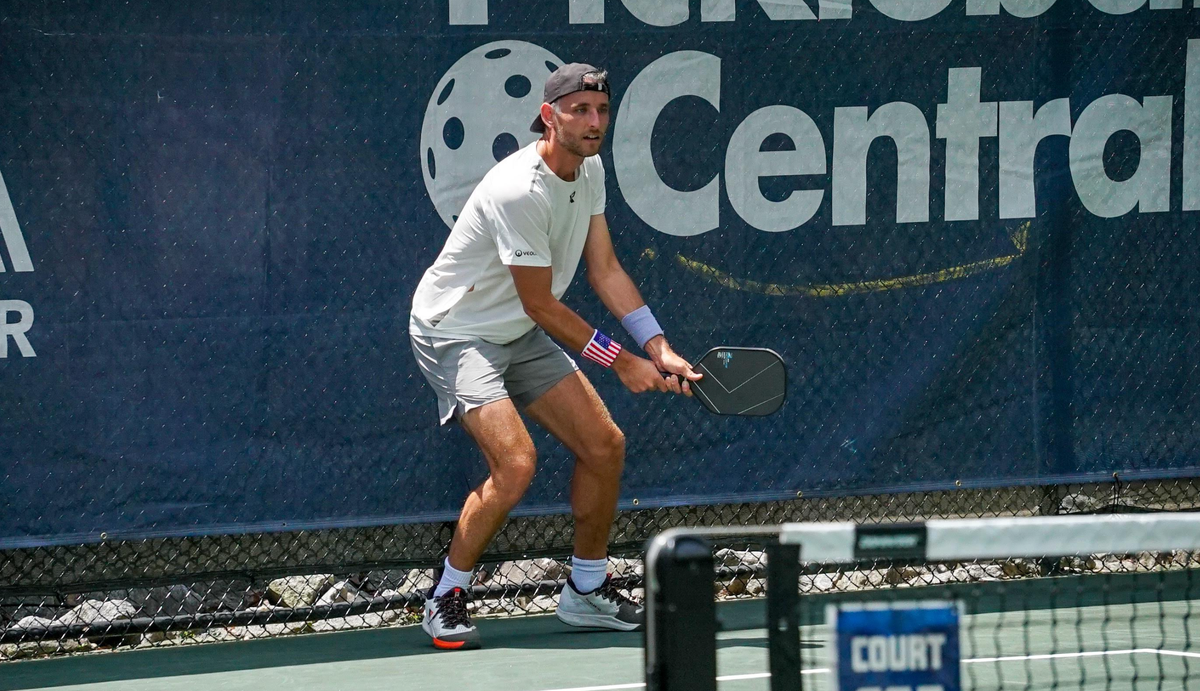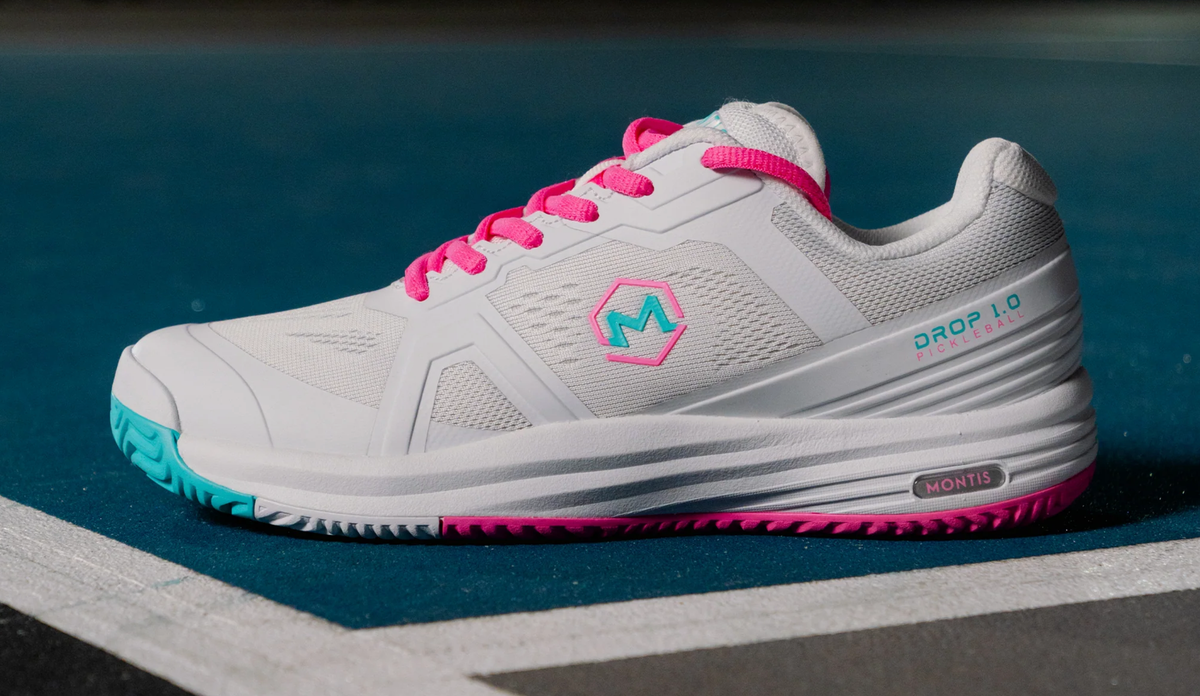
Don’t underestimate the importance of good shoes—they are often more crucial than your paddle. Proper footwear enhances performance, ensures stability, and most importantly, prevents injuries.
Why Good Shoes are Necessary
Shoes designed for pickleball provide the traction necessary for swift and lateral court movements, critical for the game’s fast pace. They reduce injury risks and discomfort, contrasting with the issues caused by inadequate footwear like running shoes, which lack court-appropriate support and can lead to sore feet or injuries.
Choosing Between Indoor and Outdoor Shoes
The choice of shoes varies significantly based on play location:
- Indoor Courts: Require shoes with soles that offer grip on smooth surfaces, like volleyball shoes featuring natural gum rubber soles.
- Outdoor Courts: Demand durable shoes with soles designed for rougher textures, similar to tennis shoes that provide support, cushioning, and durability against hard court surfaces.
Highlighted Picks
For Men
- Indoor Choice: ASICS Gel-Rocket 10
- Outdoor Selections: Tyrol Drive V Court Shoe and Mizuno Wave Enforcer Tour
For Women
- Indoor Favorites: Asics Upcourt 4 and Mizuno Wave Lightning Z6. Perfect for pickleball on gym floors.
- Outdoor Go-Tos: Asics Gel-Resolution 8 and Gel-Dedicate 7.
Sizing and Fit
Getting the right fit is crucial when selecting pickleball shoes, as the correct size impacts not only comfort but also performance and injury prevention. Here’s a more detailed look at how to ensure you get the best fit for your pickleball shoes.
Understanding Your Foot Measurements
Before shopping for new shoes, it’s essential to know your exact foot size, which includes both the length and width of your feet. Foot size can change over time, so getting measured periodically is a good practice. Here’s how to get accurate measurements:
- Measure in the Afternoon: Feet tend to swell throughout the day. Measuring your feet in the afternoon or after a typical day’s activity will help ensure a more accurate size that accommodates natural expansion.
- Wear Pickleball Socks: When measuring your feet or trying on new shoes, wear the socks you intend to play in. This ensures the fit accounts for any extra padding or thickness.
- Measure Both Feet: It’s not uncommon for one foot to be slightly larger than the other. Measure both feet and choose shoes that fit the larger foot comfortably.
- Consider Foot Width: Width is as important as length. Shoes that are too narrow can lead to blisters and circulatory problems, while too wide can cause slippage, affecting stability and control.
Deciphering Shoe Size
Once you have your foot measurements, compare them to the brand’s sizing chart. Be aware that sizing can vary between brands or even models, so it’s always best to refer to the specific sizing guide for the shoe you’re interested in.
Checking the Fit
- Toe Room: Ensure there’s about a half-inch (1.27 cm) space between your longest toe and the front of the shoe. This space prevents your toes from hitting the front of the shoe during play, especially when stopping quickly or moving downhill.
- Width Fit: Your feet should be able to spread out naturally without the sides of the shoe pressing uncomfortably against them. At the same time, the shoe should not be so wide that your foot shifts side to side.
- Heel Fit: The heel should fit snugly without slipping. Some movement is okay, but it should not be excessive, as this could lead to blisters or a lack of stability during play.
- Arch Support: Good arch support is essential, especially for players who spend long hours on the court. The shoe should comfortably accommodate the natural arch of your foot, providing support without causing undue pressure.
Trying on Shoes: When trying on shoes, mimic pickleball movements. If possible, walk around, jump slightly, and simulate lateral movements to get a feel for how the shoes will perform on the court. This can also highlight any potential issues with fit or comfort that might not be apparent when standing still.
Maintenance and Lifespan
To get the most out of your pickleball shoes, proper care and timely replacement are key. This not only ensures optimal performance but also helps in preventing injuries. Here’s an expanded look at how to maintain your shoes and understand their lifespan.
Maintenance: Keeping Shoes in Top Condition
- Regular Cleaning:
- After each use, brush off any dirt or debris with a soft brush. For synthetic materials, wiping with a damp cloth can remove most surface dirt. For tougher stains, a mild soap solution can be used sparingly.
- Leather parts should be cleaned with appropriate leather cleaners to prevent drying out or cracking. However, aggressive cleaning agents should be avoided as they can degrade the materials.
- Dealing with Moisture:
- If your shoes get wet, it’s crucial to let them air dry naturally away from direct heat sources like radiators or sunlight. This helps prevent the materials from warping or the adhesives from weakening.
- Stuffing shoes with newspaper or a towel can help absorb moisture from inside and maintain the shoe’s shape during the drying process.
- Odor Management:
- To keep shoes smelling fresh, consider using moisture-absorbing inserts or sprays designed for athletic shoes. These can help control odor without damaging the shoe’s interior.
- Regular airing out of shoes also prevents the buildup of odor-causing bacteria.
- Storage:
- Store your shoes in a cool, dry place where they can air out properly. Avoid leaving them in your bag, car, or other enclosed spaces where moisture and heat can accumulate.
- Using a shoe tree can help maintain the shape of the shoe and prevent creases, especially in leather models.
Lifespan: Knowing When to Replace Your Shoes
- Wear and Tear:
- Pay attention to the outsole’s tread pattern. Significant wear in high-contact areas, like the heel or ball of the foot, can reduce traction and stability, increasing the risk of slips and falls.
- Check for any separation between the sole and the upper part of the shoe, as this can affect the structural integrity and support.
- Cushioning and Support:
- Over time, the midsole, which provides cushioning and support, can compress and lose its effectiveness. This is often less visible but can lead to discomfort and increased impact stress on your joints.
- If you start to notice new aches or pains after playing, it might be time for a new pair, even if the shoes still look outwardly okay.
- Fit Changes:
- Shoes can stretch or deform slightly with use, leading to a less secure fit. If your shoes feel looser or less supportive, despite proper lacing, they may be nearing the end of their useful life.
- Frequency of Use and Playing Surface:
- Players who hit the courts frequently or play primarily on rough surfaces will likely need to replace their shoes more often. As a general guideline, serious players might consider evaluating their shoes every 3-6 months, while casual players may get a year or more of use.
Cost of Pickleball Shoes
When you’re investing in quality pickleball shoes, understanding the balance between price and value is key. Here’s a closer look, including average price ranges to guide your budgeting.
Price vs. Value
Long-term Savings: High-quality shoes, though pricier upfront, offer long-term savings. They’re built to last, meaning you won’t have to replace them as frequently as cheaper options. Over time, the cost per wear can actually make them more economical.
Average Prices
- Budget-Friendly Options: Start around $60-$80. These shoes might lack some advanced features but still offer basic support and durability.
- Mid-Range Quality: Expect to pay between $100-$140 for shoes that offer a balance of performance, comfort, and durability. This range is typically where you find the best value for serious recreational players.
- High-End Models: Can go from $150 and up. These shoes incorporate the latest technologies and materials for optimal performance and comfort. They’re often chosen by very competitive or professional players.
Spotting Quality within Your Budget:
- Brand Research: Some brands are renowned for their quality in sports footwear. Search these brands and compare their offerings in your price range.
- Hunt for Deals: Sales, discounts on last season’s models, and clearance events are excellent opportunities to snag high-quality shoes at a lower price.
Special Consideration for Seniors
Seniors should prioritize shoes that offer excellent balance and reduce the risk of falls, opting for models with less aggressive tread designs that still provide necessary lateral support for pickleball’s quick movements.
Also many seniors rely on custom orthotics for various foot conditions, so hoes with removable insoles will offer the flexibility to replace them with orthotic inserts.
Conclusion
Choosing the right pickleball shoes is as important as any other equipment choice in the sport. Prioritize footwear that offers the right balance of support, traction, and comfort, tailored to your playing surface. Feel free to leave a comment below with any questions or insights that you may have, and let us know if you want us to review a specific shoe.
At Pickleball Portal, we bring you the latest updates, honest news and storytelling, comprehensive how-to guides, expert player advice, and in-depth product reviews & recommendations. Everything you read is original and brought to life by our team of dedicated contributors and trusted personalities. Whether you’re picking up a paddle for the first time or you’re an experienced player, join us as we delve into the heart of the pickleball community. | Instagram | Twitter | [email protected]
Anuncie Aqui / Advertise Here
Sua marca para o mundo Pickleball! / Your brand for the Pickleball world!

 English
English  Spanish
Spanish  Portuguese
Portuguese  German
German  Italian
Italian  Japanese
Japanese  French
French  Polish
Polish  Russian
Russian  Netherlands
Netherlands  Hungarian
Hungarian  Turkish
Turkish  Videos
Videos  Pickleball Portal
Pickleball Portal








 English (US) ·
English (US) ·  Portuguese (BR) ·
Portuguese (BR) ·